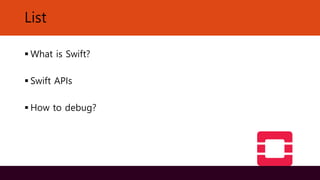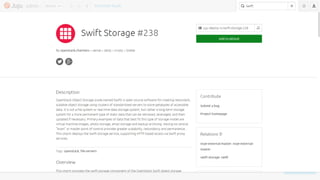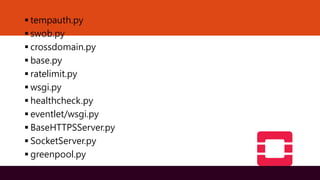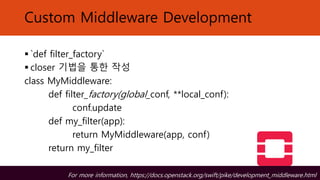OpenStack Swift Debugging
- 1. OpenStack Swift Debugging OpenStack Korea Community Study Organizer 장태희
- 2. List ▪ What is Swift? ▪ Swift APIs ▪ How to debug?
- 3. 2017년 Openstack Swift 분석 스터디 ▪ Study Lead : 조성수 ▪ Study Period : 2017.04.11 ~ 2017.07 ▪ 장소 제공 : Naver D2 ▪ 산출물 공유 : Github(https://git.io/vdvHv)
- 5. What is Swift? ▪ OpenStack Object Store project(Object Storage) ▪ Store data as objects. ▪ Offers cloud storage software, store and retrieve lots of data with a simple API. ▪ swift-proxy, account, container, object로 구성됩니다. ▪ Swift-proxy는 account, container, object를 관리, Object API를 제공 ▪ Account, Container는 DB로 데이터가 관리되며, Object는 저장공간에 직접 저장되는 방식으로 설계 되어 있습니다. ▪ User는 API를 통하여 데이터를 저장하거나 다운로드 For more information, please visit https://docs.openstack.org/swift/latest Source) http://naleejang.tistory.com/104
- 6. Swift URl ▪ http://host/v1/account/container/object ▪ v1 : api version ▪ account : account name in swift ▪ container : container name ▪ object : object name For more information, please visit https://docs.openstack.org/swift/latest
- 7. Swift APIs ▪ account – accounts in swift. ▪ container – same concept of Amazon S3 bucket. objects are stored in container. ▪ object - data such as documents, files, and movies. Available to save w ith metadata
- 8. Swift APIs ▪ account – accounts in swift.
- 9. Swift APIs ▪ container – same concept of Amazon S3 bucket. objects are stored in container.
- 10. Swift APIs
- 11. Swift Components ▪ proxy-server ▪ Provide Swift API and relay requests to backend servers(accout, container, object) ▪ account-server ▪ Save swift account information. Shows information amounts of container per accounts, storage usage. ▪ container-server ▪ Save container information of accounts
- 12. Swift Components ▪ object-server ▪ Store real objects. Each objects has basically 3 replications. ▪ Daemon ▪ Numeral daemons must be executed due to the fact that swift is eventual consistency system so that it should sustain consistency.
- 14. How to debug OpenStack Swift
- 15. ▪ Create a loopback device for storage ▪ ignore erasurecode library
- 16. Make VM for OpenStack Test Bench
- 17. Pycharm Development Environment ▪ Same swift code on Native OS and Virtual Machine. ▪ Required : Pycharm Professional Edition.
- 18. Summary) koain 김영우 - https://git.io/v5jpA
- 19. Summary) koain 김영우 - https://git.io/v5jpA
- 20. Summary) koain 김영우 - https://git.io/v5jpA
- 21. Summary) koain 김영우 - https://git.io/v5jpA
- 22. Summary) koain 김영우 - https://git.io/v5jpA
- 23. Summary) koain 김영우 - https://git.io/v5jpA
- 24. Summary) koain 김영우 - https://git.io/v5jpA
- 25. Summary) koain 김영우 - https://git.io/v5jpA
- 26. ▪ tempauth.py ▪ swob.py ▪ crossdomain.py ▪ base.py ▪ ratelimit.py ▪ wsgi.py ▪ healthcheck.py ▪ eventlet/wsgi.py ▪ BaseHTTPSServer.py ▪ SocketServer.py ▪ greenpool.py
- 28. /swift/common/middleware/tempauth.py ▪ token 인증을 처리하는 부분 ▪ URL은 어떻게 제공되는가? ▪ 원하는 대상 정하기 ▪ request에 보낸 내용을 가지고 보기 ▪ request를 보내는 것이 없으면 log를 가지고 (log가 찍혔다면 code가 지나간 자리이므로) 해당 부분을 검색하여 string을 검 색
- 29. /swift/common/middleware/tempauth.py ▪ account_user = account + ':' + user -> 유저 인증 시작 부분(user와 group이 정상적인지 이전에 확인) ▪ if self.users[account_user]['key'] != key -> 키 검사 ▪ account_id = self.users[account_user]['url'].rsplit('/', 1)[-1] -> 계정 id 가져오기 ▪ if not token: -> token이 생성되는 과정을 볼 수 있다 ▪ resp = Response(request=req, headers={ -> token이 모두 발급 된 것을 확인 ▪ X-Auth Token을 언제 가져오는가? ▪ token = env.get('HTTP_X_AUTH_TOKEN', env.get('HTTP_X_STORAGE_TOKEN'))
- 30. /swift/common/middleware/tempauth.py ▪ 유효성 검사 ▪ breaking point : groups = self.get_groups(env, token) ▪ memcache_token_key = '%s/token/%s' % (self.reseller_prefix, token) ▪ memcache_token_key = '%s/token/%s' % (self.reseller_prefix, token) ▪ token의 문자열을 검사 하는 것이 아니라, memcache에서 무엇 인가를 가져와서 비교하는구나 라고 알게 됨.
- 31. /swift/commom/middleware/proxy-logging.py ▪ Logging middleware for the Swift proxy. ▪ `client_ip remote_addr datetime request_method request_path protocol status_int user_agent auth_token bytes_recvd bytes_sent client_etag transaction_id headers request_time source log_info request_start_time request_end_time` ▪ url 인코딩되고, 스페이스로만 구분되므로 `split()`으로 간단히 구분이가능
- 32. /swift/commom/middleware/proxy-logging.py ▪ `remote_addr` : `REMOTE_ADDR` 환경변수 값 ▪ `client_ip` : `X-Forwarded-For` 해더, `x-Cluster_Ip` 해더, `REMOTE_ADDR` 환경 변수 값들을 나타낸다. ▪ `source` : WSGI 환경에서의 `swift.source` 를 나타낸다. 요청을 생성 한 코드를 나타냄 ▪ `log_info`WSGI 환경에서의 `swfit.log_info` 값을 나타낸다. ▪ `x-delete-at` 값이나 일반 로그 정보에서 감지할 수 없는 <b>뒤에서 동작하는</b> 코드들에 대한 추가 정보를 내보냄. ▪ 로그 추가시`env.setdefault('swift.log_info', []).append(your_info)` 를 이용하여 다른 사람들과의 로그와 충돌이 없도록 해야 함. ▪ 헤더 값이 없거나, 누락된 값, 0은 일반적으로 `-` 로 표기.
- 33. /swift/commom/middleware/proxy-logging.py ▪ config 값 ▪ `self.log_hdrs` ▪ `access_log_haders` 가 있으면 해당 값을 읽어오고 없으면 `log_headers`를 읽어오는데 그것도 없으면 `no`로 설정 ▪ `log_hdrs_only` : `access_log_headers_only` 값이 존재하면 `log_hdrs_only` 값에다가 리스트로 가지고 있음. ▪ `self.valid_methods` : `access_log_statsd_valid_http_methods` 값을 가져오며, 없으면 `log_statsd_valid_http_methods` > `GET,HEAD,POST,PUT,DELETE,COPY,OPTIONS` 순으로 값을 가져오게 된다. ▪ 해당내역도 각 항목별로 string list로 구성된다.
- 34. DLO / SLO ▪ /swift/commom/middleware/dlo.py ▪ D(Dynamic)LO : 파일을 무한정 올릴 수 있다. multipart 종료 시점을 알 수 없음. ▪ req = Request() 객체를 어떻게 잘 활용하는지, Debugging point, 분기 를 눈에 익히는것이 목적 ▪ /swift/commom/middleware/slo.py ▪ S(Static)LO : multipart 업로드 종료 이후 더이상 part 업로드 불가.
- 37. Custom Middleware Development ▪ `def filter_factory` ▪ closer 기법을 통한 작성 class MyMiddleware: def filter_factory(global_conf, **local_conf): conf.update def my_filter(app): return MyMiddleware(app, conf) return my_filter For more information, https://docs.openstack.org/swift/pike/development_middleware.html
- 38. Custom Middleware Development ▪ pipeline에서 동작시 wsgi.py module이 어느 클래스를 로드 할지 결정.(paste.filter_factory 부분) ▪ wsgi가 각 middleware의 클래스들을 초기화 시켜준다. ▪ 각 middleware별 특정 변수들은 local_conf에 저장 ▪ app parameter는 다음에 호출 할 middleware를 가리킴. ▪ 문서에 나온것과 달리 middleware는 따로 repository를 만들어서 관리. 이후 설치할 수 있는 설치형으로 만듬. ▪ setup.py에 pbr 설정을 한 뒤 setup.cfg에 swift를 설치하듯이 설치.
- 39. proxy/server.py __call__ ▪ wsgi가 부르는 함수, 한번 인증된 키에 대해서는 memcached 가 가지고 있어 Keystone으로 갈 필요가 없음 ▪ proxy server -> proxy/containers/server.py 가 핵심
- 40. Cluster ▪ cluster에서 region을 생성한다.(여러개가 될 수 있음) ▪ 여러개의 region ▪ region 간은 독립된 환경이어야 함. (전기, 네트워크 등) ▪ region 안에 여러개의 zone ▪ 여러개의 rack을 묶어 region을 만들 수도 있고, 하나의 데이터 센터를 region으로 할 수도 있다. ▪ 각 region은 독립된 전원과 네트워크 등을 사용해야 한다.
- 41. Cluster ▪ zone은 하나의 rack이라고 보면 된다. ▪ zone은 하나의 랙이라고 봐도 무방 ▪ 한 열이 zone이 될수도, 랙 여러개가 zone이 될수도 있음 ▪ zone안에 여러개의 node ▪ node는 서버라고 봐도 무방 ▪ node안에 여러개의 하드디스크 ▪ node는 각 서버 장비라고 보면 된다. ▪ hash 알고리즘은 md5를 기본으로 사용.
- 42. 분산 시스템 - consistence hash ring Source) http://www.paperplanes.de/2011/12/9/the-magic-of-consistent-hashing.html
- 43. Account / Container ▪ account와 container는 database에 접근하는 코드 구조가 비슷 ▪ account/server.py ▪ PUT -> proxy 서버에서 request를 받을 때에는 http://prox_svr/v1/account/container/obj ▪ PUT에서 database로 request를 보낼 때에는 http://account_server/v1/sdb1/70/account/obj 로 바뀌어 보내 게 된다. ▪ account 생성 == db file 생성
- 44. Account / Container ▪ db.py -> initialize == sqlite에 table을 만드는 것 까지만 진행 ▪ PUT 요청 -> db 파일을 하나 생성하고 원하는 이름은 rename 으로 db 파일을 생성한다. PUT 명령이 오면 실제 sqlite에 바로 쓰는것이 아니라 pending 파일에 기록하고, pending 파일이 일 정 capacity를 넘어서면 .lock 파일로 모든 요청을 잠시 막고 db 에 기록한다.
- 45. Account / Container ▪ GET 요청 -> 모든 요청을 잠시 막고 pending에 있는 것을 db에 merge시킨 뒤 db를 읽어온다. ▪ DELETE -> table field에 DELETED라고 flag 표시만 하고 실제 지우지는 않는다. 나중에 auditor daemon이 돌면서 실제 파일 을 지운다.





























![/swift/common/middleware/tempauth.py
▪ account_user = account + ':' + user -> 유저 인증 시작 부분(user와
group이 정상적인지 이전에 확인)
▪ if self.users[account_user]['key'] != key -> 키 검사
▪ account_id = self.users[account_user]['url'].rsplit('/', 1)[-1] -> 계정
id 가져오기
▪ if not token: -> token이 생성되는 과정을 볼 수 있다
▪ resp = Response(request=req, headers={ -> token이 모두 발급 된
것을 확인
▪ X-Auth Token을 언제 가져오는가?
▪ token = env.get('HTTP_X_AUTH_TOKEN',
env.get('HTTP_X_STORAGE_TOKEN'))](https://image.slidesharecdn.com/20170922swift-debugging-2-180330044108/85/OpenStack-Swift-Debugging-29-320.jpg)


![/swift/commom/middleware/proxy-logging.py
▪ `remote_addr` : `REMOTE_ADDR` 환경변수 값
▪ `client_ip` : `X-Forwarded-For` 해더, `x-Cluster_Ip` 해더,
`REMOTE_ADDR` 환경 변수 값들을 나타낸다.
▪ `source` : WSGI 환경에서의 `swift.source` 를 나타낸다. 요청을 생성
한 코드를 나타냄
▪ `log_info`WSGI 환경에서의 `swfit.log_info` 값을 나타낸다.
▪ `x-delete-at` 값이나 일반 로그 정보에서 감지할 수 없는 <b>뒤에서
동작하는</b> 코드들에 대한 추가 정보를 내보냄.
▪ 로그 추가시`env.setdefault('swift.log_info', []).append(your_info)` 를
이용하여 다른 사람들과의 로그와 충돌이 없도록 해야 함.
▪ 헤더 값이 없거나, 누락된 값, 0은 일반적으로 `-` 로 표기.](https://image.slidesharecdn.com/20170922swift-debugging-2-180330044108/85/OpenStack-Swift-Debugging-32-320.jpg)












